Voyager to the Pacifica: 2017 Chrysler Pacifica vs. 1984 Plymouth Voyager
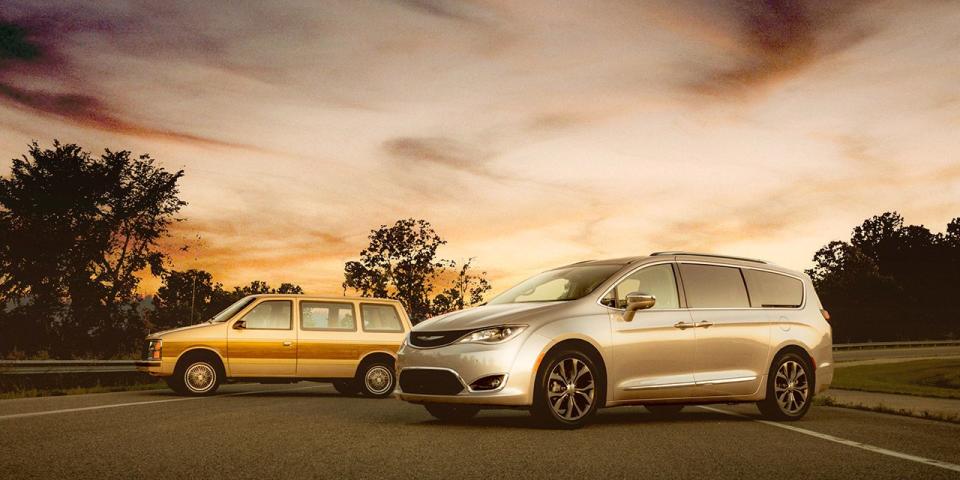
There was a Ghostbusters movie in 1984, and there’s one this year. Game of Thrones is really just Falcon Crest with more dragons and beheadings. The Libertarians didn’t stand a chance then and don’t now. Just look at these two seven-seat minivans, both driving out of Chrysler’s Windsor, Ontario, assembly plant and into the North American zeitgeist. They’re completely different vans, and yet exactly the same. It’s a mind-blowing paradox.
The old one is Magic Wagon No. 1, the actual preproduction 1984 Plymouth Voyager that Chrysler’s then CEO, Lee Iacocca, used at press unveilings, dealer meetings, and general cheerleading sessions to drum up enthusiasm for the new “T115” minivans. Stray badges shoved into a rear cubby indicate that it sometimes also appeared as a Dodge Caravan. There are about 12,000 miles on the clock, and fake wood forests the sides. A lot of corduroy cows died to upholster those seats.
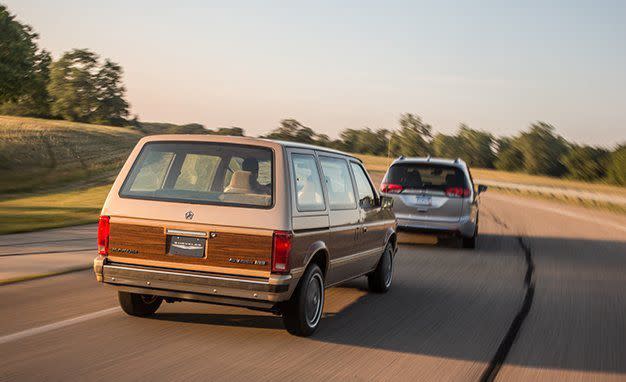
The new one is a 2017 Chrysler Pacifica, the state of the art in a vehicle category that’s notoriously artless. It has command thrones up front, second-row seats that disappear into the floor, third-row seating that drops into a deep well, and hides from real cows to cover them all. If the glass sunroof were any more panoramic it would have to be continued on the next van.
The front-drive minivan was a Hail Mary pass thrown up by a team ready to be shoved out of the league. The K-car’s success had given Chrysler just enough freedom to take a big chance on reinventing family transportation. If it worked, the company would pay off its government-guaranteed loans and proceed onward to prosperity under Iacocca’s enlightened whip. If the minivan turned out to be a sales turd, well, Chrysler was going bankrupt anyhow. The company couldn’t afford the extra paper to write down a Plan B.

Chrysler’s timing was perfect. The minivan appeared just as baby boomers hit optimal fertility and their contempt for station wagons peaked. In contrast to the massive acreage of a Country Grand Safari Estate Cruiser, the minivan was adorably dorky; a friendly module that fit in garages, nimbly slalomed through parking lots, and had a big door on the side through which to throw toddlers. It did everything a mom-mobile had to do, but more efficiently and without the crushing wagon shame.
Change is inevitable, though, and the generation that grew up in minivans is now in its own stage of prime progeny creation. And they’ve largely stigmatized the minivan as the official shuttle between home and Blue Field No. 4 hell. So crossovers rule, even though the minivan has evolved into a vastly capable suburban multi-tool.
Is this a specious comparison? Is it polluted with nostalgia, addled with spurious allusions, and basically absurd? Damn straight. But we couldn’t find a first-gen Porsche 911 with which to do that car-magazine cliché thing, comparing the old one against the new one, so we figured this would be just as good. Plus, driving these two back to back proved oddly enlightening, even though we couldn’t take the oldster past 45 mph on a loop at Chrysler’s Chelsea, Michigan, proving grounds. Of course the new van is better. It’s also worse. So?
They grow up so fast.
The Pacifica dwarfs the original minivan. But it’s also longer than the long-wheelbase version of the full-size 1984 Dodge Ram Van. And its V-6 makes 152 more horsepower than the Ram Van’s optional V-8.

First-generation Chrysler minivans are nearly extinct. The few listed on eBay or Craigslist are basket cases selling for three figures. Ferraris are more common on the road. And virtually all the minivans that clogged the parking lots at Circuit City and Montgomery Ward were long ago recycled into Chinese rebar. So driving this pristine one, literally pulled from the Chrysler museum for C/D’s amusement, is rare air. Maybe even, almost, this close to exciting.
Every square millimeter of the Voyager is useful, and square is how it’s designed. The pillars are straight edges, the interior surfaces flat, and the seats bolt-upright. Even almost 33 years after its debut, the sheer compact logic of this boxy design is astonishing. Heather Thomas had the curves, not Chrysler.
Inside the box, it’s all black and brown tones with squishy, soft-but-comfortable front buckets and two rows of benches all finished in a crosshatch ribbed fuzz that may be coming back into fashion. The instrumentation, switches, column-mounted shifter, and steering wheel are all bits swiped from the K-car. It not only is roomy, it feels roomy. There’s loads of glass and not even a glovebox to intrude on the front passenger’s kneeroom. A pull-out drawer under that passenger’s seat provides storage.
The front windows can be manually cranked down, but the side windows behind only swing out about an inch for ventilation. There are three ashtrays because even the kids in back should have a spot to snuff out their butts. Cupholders, a breakthrough innovation in the early ’80s, are molded into the side panels in back. There are also two mysterious molded rings atop the radio’s dash housing that suggest cupholders but are useless. Like everything in the Voyager, the single muscle-powered sliding side door operates with a light touch. But there’s no stop to hold it in the open position. That technology was in the far-off future.
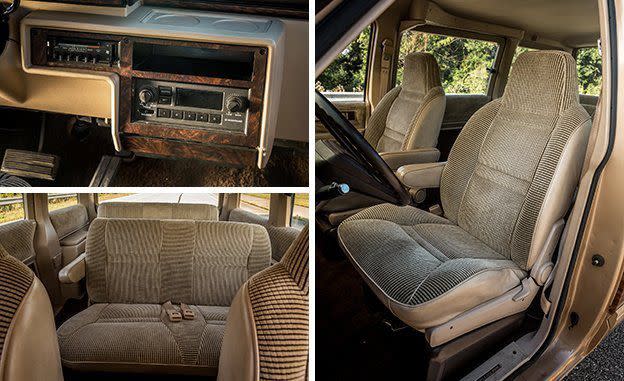
Iacocca’s Voyager has the standard 2.2-liter overhead-cam, eight-valve, four-cylinder engine lashed to a three-speed automatic transaxle. Barely gasping through a two- barrel carburetor, the 2.2 was rated at 101 horsepower. Of course it was slow-scary slow. C/D drove a Voyager powered by the optional Mitsubishi-made, 99-hp 2.6-liter four, and it slogged to 60 mph in 14.0 seconds and through the quarter-mile in 19.5 seconds at 71 mph. The 2.2 should run within a couple tenths of those performances.
But moms aren’t racers, and the headline feature was front-wheel drive, which allowed a flat floor. It was a sharp contrast to the convoluted floorpans of conventional station wagons that made accommodating many loads difficult and segregated passengers in their own holes.
It’s best to let the thin, plastic steering wheel dance along under your fingers. The hydraulic power steering isn’t quick or communicative, and the 205-section Goodyear whitewalls on 14-inch wheels (185s were standard in ’84) don’t have much to report back anyhow. The ride from the front MacPherson struts is comfortable enough while a solid axle on leaf springs keeps things jiggly in back. Plenty of rattles and tremors ripple through the structure even on seemingly smooth roads, and both were present in C/D’s first test three decades ago, too. This is a lightly built vehicle, and it feels it, with a curb weight under 3400 pounds.
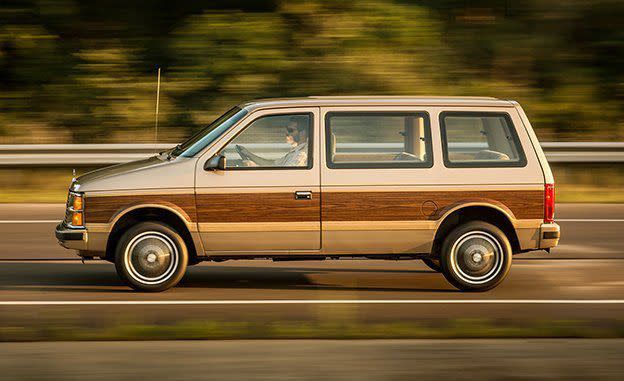
Such lightness is practically a novelty in the 21st century, and would make the Voyager compelling even if it weren’t a childhood artifact. It’s a reminder that progress often comes at some cost. The five-passenger Voyager started at $9075 in 1984, which translates to $21,053 in 2016 dollars. Throw a load of options on a seven-passenger model, and the price crested over $14,000-about $32,834 today. But roll-up windows aren’t even an option on the Pacifica.
There were tough choices to be made in 1984. For God’s sake, Knight Rider and Hardcastle and McCormick were on at the exact same time on Sunday nights. And only rich people had VCRs. But choosing to buy a Chrysler minivan over the era’s wallowing wagons? That was easy.
Compared with the raw old Voyager, the Pacifica Limited is a sensory deprivation chamber. It’s quiet, composed, easygoing, and thick in all the places where the Voyager is thin. Yeah, all the radar-based this, HDMI-fed that, and USB-whatever would be pure Cybotron Techno City fantasy to 1984 eyes and ears, but it’s the Pacifica’s structure and substance that are most impressive.
The Pacifica is 27.9 inches longer, 10.0 inches wider, and 5.4 inches taller than the original Voyager. It’s a 4557-pound behemoth that feels every inch of its size, every ounce of its weight, and every dollar of its $49,450 as-tested price. Somewhere along the evolution of Chrysler’s minivan, the mini part was assassinated.
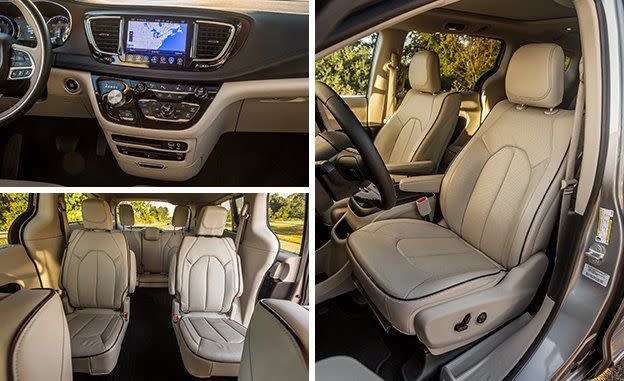
Inside this new van, Chrysler has produced a cabin that feels as if it should have wings and jet engines attached to it. But its most impressive trick is still the now-standard Stow ’n Go second-row seats that fold into wells beneath the floor. Combined with the foldaway third-row bench, flattening the floor of the Pacifica takes about as much time as it does to release one seat latch on the Voyager’s removable benches. Once you do, you’ll have 141 cubic feet in which to reenact a Star Wars light-saber fight from either A New Hope or The Force Awakens.
What road noise isn’t blocked out of the Pacifica by its impressive new steel structure is reduced by its active noise-cancellation system. Meanwhile, the weight saved by the aluminum control arms on the strut-front suspension is likely obliterated by the weight of the optional 20-inch aluminum wheels and 245/50R-20 tires. And yes, there’s a vacuum cleaner mounted amidships in the Limited to attack the family debris field. It sucks.
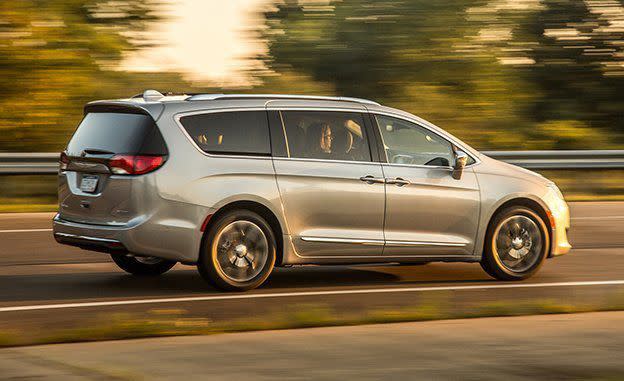
While a plug-in-hybrid Pacifica is coming soon, currently the only powertrain offered is the familiar 3.6-liter Pentastar V-6 feeding Chrysler’s now-ubiquitous nine-speed automatic transaxle. With 287 horsepower aboard, it takes the Pacifica a scant 7.3 seconds to reach 60 mph, or about half the time the Voyager needs. And it hits the quarter-mile mark nearly four seconds before the Voyager gets there. Despite all that, it betters the Voyager’s EPA-rated 17-mpg city fuel economy by 1 mpg, and its 28-mpg highway rating is a full 8 mpg better than its ancient ancestor’s, even with the 1984 figures updated to today’s more conservative ratings.
But the newer transmission is sort of slow and stupid. It takes its time deciding exactly which cog to choose from its smorgasbord of gears, and if you do something unexpected with the throttle, the transmission sometimes can’t keep up and hangs there inert. During cruises, it will randomly try various gears, apparently out of pure whimsy.
The T115 evolved into today’s Pacifica through a series of incremental steps, most of which couldn’t have been predicted 32 years ago. But as refined as this new van is, it’s missing the direct mechanical engagement of its ancestor. It needs a touch more Dukes of Hazzard and a little less Airwolf.
2017 Chrysler Pacifica Limited1984 Plymouth Voyager LE*VehiclePrice as Tested$49,450$32,834†Base Price$43,490$22,025†DimensionsLength203.8 inches175.9 inchesWidth79.6 inches69.6 inchesHeight69.9 inches64.2 inchesWheelbase121.6 inches112.0 inchesFront Track68.3 inches59.9 inchesRear Track68.3 inches62.1 inchesInterior VolumeF: 58 cu ft
M: 54 cu ft
R: 47 cu ft
F: 50 cu ft
M: 43 cu ft
R: 42 cu ftCargo Behind Front Seats141 cubic feet125 cubic feetPowertrainEngineDOHC 24-valve V-6
220 cu in (3605 cc)SOHC 8-valve inline-4
156 cu in (2555 cc)Power HP @ RPM287 @ 640099 @ 4800Torque LB-FT @ RPM262 @ 4000143 @ 2000Redline / Fuel Cutoffnone/6500 rpmnone/5000 rpmLB Per HP15.934.3DrivelineTransmission9-speed automatic3-speed automaticDriven WheelsfrontfrontGear Ratio:1/
MPH Per 1000 RPM/
Max MPH1 4.70/4.8/31
2 2.84/7.9/51
3 1.91/11.8/77
4 1.38/16.3/106
5 1.00/22.6/112
6 0.81/27.9/112
7 0.70/32.2/112
8 0.58/38.9/112
9 0.48/47.0/1121 2.69/8.4/42
2 1.55/14.7/74
3 1.00/22.7/94Axle Ratio:13.253.22ChassisSuspensionF: struts, coil springs, anti-roll bar
R: multilink, coil springsF: truts, coil springs, anti-roll bar
R: rigid axle, leaf springsBrakesF: 13.0-inch vented disc
R: 13.0-inch discF: 10.2-inch vented disc
R: 9.0-inch drumStability Controltraction offnoneTiresFalken Ziex CT50 A/S
245/50R-20 102V M+SGoodyear Vector
P195/75R-14 M+SC/D Test ResultsAcceleration0–30 MPH2.7 sec4.4 sec0–60 MPH7.3 sec14.0 sec0–80 MPH12.5 sec27.0 sec0–100 MPH20.2 sec-¼-Mile @ MPH15.8 sec @ 9119.5 sec @ 71Rolling Start, 5–60 MPH7.9 sec-Top Gear, 30–50 MPH4.3 sec6.1 secTop Gear, 50–70 MPH5.6 sec10.1 secTop Speed112 mph (gov ltd)94 mph (drag ltd)ChassisBraking 70–0 MPH177 feet256 feetRoadholding,
300-ft-dia Skidpad0.83 g‡0.68 gWeightCurb4557 pounds3400 pounds%Front/%Rear55.1/44.957.9/42.1FuelTank19.0 gallons20.0 gallonsRating87 octane87 octaneEPA City/Hwy22/18/28 mpg18/17/20 mpgC/D Observed20 mpg20 mpgSound LevelIdle38 dBA50 dBAFull Throttle76 dBA74 dBA70-MPH Cruise69 dBA71 dBA
*April 1984 road-test results †Adjusted for inflation ‡Stability-control inhibited Pacifica tested by K.C. Colwell in Chelsea, MI
Voyager tested by Csaba Csere in Irvine, CA
Final ResultsMax Pts. Available2017 Chrysler Pacifica Limited1984 Plymouth Voyager LERank12VehicleDriver Comfort1098Ergonomics1088Second-row Comfort555Second-row Space*55 3Third-row Comfort555Third-row Space*552Cargo Space*553Features/Amenities*10101Fit and Finish1086Interior Styling10810Exterior Styling1088Rebates/Extras*510As-tested Price*201020Subtotal1108779Powertrain1/4-mile Acceleration*20208Fuel Economy*101010Engine NVH1096Transmission1086Subtotal554730ChassisPerformance*202010Steering Feel1088Brake Feel1086Handling1096Ride10107Subtotal605537ExperienceFun to Drive251520Grand Total245204166
* These objective scores are calculated from the vehicle's dimensions, capacities, rebates and extras, and/or test results.
('You Might Also Like',)

 Yahoo Autos
Yahoo Autos 